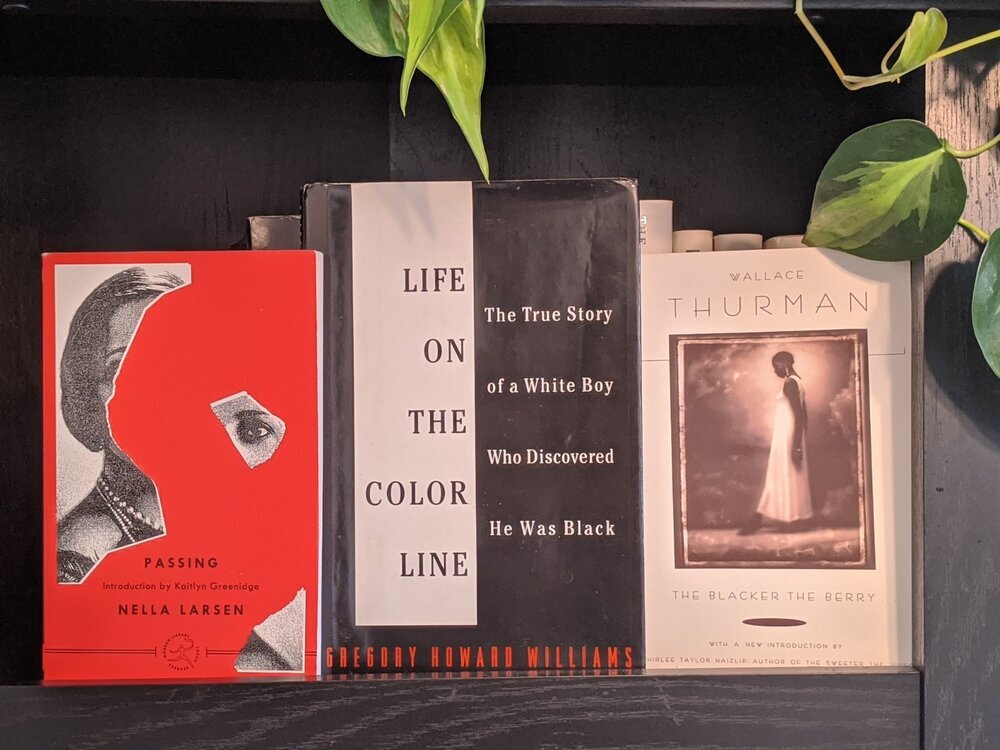Colorism Collection
Passing by Nella Larsen
Nella Larsen's 1929 novella follows friends Irene Redfield and Clare Kendry, two black women who pass as white. Their anxieties about passing culminate in tragedy, revealing the powerful repercussions of hiding one's identity. Nearly a century later, Larsen's exploration of race remains urgent and relevant as ever.
Life on the Color Line: The True Story of a White Boy Who Discovered He Was Black
As a child in 1950s segregated Virginia, Gregory Howard Williams grew up believing he was white. But when the family business failed and his parents’ marriage fell apart, Williams discovered that his dark-skinned father, who had been passing as Italian-American, was half black. The family split up, and Greg, his younger brother, and their father moved to Muncie, Indiana, where the young boys learned the truth about their heritage. Overnight, Greg Williams became black.
In this extraordinary and powerful memoir, Williams recounts his remarkable journey along the color line and illuminates the contrasts between the black and white worlds: one of privilege, opportunity and comfort, the other of deprivation, repression, and struggle. He tells of the hostility and prejudice he encountered all too often, from both blacks and whites, and the surprising moments of encouragement and acceptance he found from each.
The Blacker the Berry
his novel, associated with the Harlem Renaissance, is considered groundbreaking for its exploration of colorism and racial discrimination within the black community, where lighter skin was often favored, especially for women. The novel tells the story of Emma Lou Morgan, a young black woman with dark skin. It begins in Boise, Idaho and follows Emma Lou in her journey to college at USC and a move to Harlem, New York City for work. Set during the Harlem Renaissance, the novel explores Emma Lou's experiences with colorism, discrimination by lighter-skinned African Americans due to her dark skin. She learns to come to terms with her skin color in order to find satisfaction in her life.
Passing by Nella Larsen
Nella Larsen's 1929 novella follows friends Irene Redfield and Clare Kendry, two black women who pass as white. Their anxieties about passing culminate in tragedy, revealing the powerful repercussions of hiding one's identity. Nearly a century later, Larsen's exploration of race remains urgent and relevant as ever.
Life on the Color Line: The True Story of a White Boy Who Discovered He Was Black
As a child in 1950s segregated Virginia, Gregory Howard Williams grew up believing he was white. But when the family business failed and his parents’ marriage fell apart, Williams discovered that his dark-skinned father, who had been passing as Italian-American, was half black. The family split up, and Greg, his younger brother, and their father moved to Muncie, Indiana, where the young boys learned the truth about their heritage. Overnight, Greg Williams became black.
In this extraordinary and powerful memoir, Williams recounts his remarkable journey along the color line and illuminates the contrasts between the black and white worlds: one of privilege, opportunity and comfort, the other of deprivation, repression, and struggle. He tells of the hostility and prejudice he encountered all too often, from both blacks and whites, and the surprising moments of encouragement and acceptance he found from each.
The Blacker the Berry
his novel, associated with the Harlem Renaissance, is considered groundbreaking for its exploration of colorism and racial discrimination within the black community, where lighter skin was often favored, especially for women. The novel tells the story of Emma Lou Morgan, a young black woman with dark skin. It begins in Boise, Idaho and follows Emma Lou in her journey to college at USC and a move to Harlem, New York City for work. Set during the Harlem Renaissance, the novel explores Emma Lou's experiences with colorism, discrimination by lighter-skinned African Americans due to her dark skin. She learns to come to terms with her skin color in order to find satisfaction in her life.
Passing by Nella Larsen
Nella Larsen's 1929 novella follows friends Irene Redfield and Clare Kendry, two black women who pass as white. Their anxieties about passing culminate in tragedy, revealing the powerful repercussions of hiding one's identity. Nearly a century later, Larsen's exploration of race remains urgent and relevant as ever.
Life on the Color Line: The True Story of a White Boy Who Discovered He Was Black
As a child in 1950s segregated Virginia, Gregory Howard Williams grew up believing he was white. But when the family business failed and his parents’ marriage fell apart, Williams discovered that his dark-skinned father, who had been passing as Italian-American, was half black. The family split up, and Greg, his younger brother, and their father moved to Muncie, Indiana, where the young boys learned the truth about their heritage. Overnight, Greg Williams became black.
In this extraordinary and powerful memoir, Williams recounts his remarkable journey along the color line and illuminates the contrasts between the black and white worlds: one of privilege, opportunity and comfort, the other of deprivation, repression, and struggle. He tells of the hostility and prejudice he encountered all too often, from both blacks and whites, and the surprising moments of encouragement and acceptance he found from each.
The Blacker the Berry
his novel, associated with the Harlem Renaissance, is considered groundbreaking for its exploration of colorism and racial discrimination within the black community, where lighter skin was often favored, especially for women. The novel tells the story of Emma Lou Morgan, a young black woman with dark skin. It begins in Boise, Idaho and follows Emma Lou in her journey to college at USC and a move to Harlem, New York City for work. Set during the Harlem Renaissance, the novel explores Emma Lou's experiences with colorism, discrimination by lighter-skinned African Americans due to her dark skin. She learns to come to terms with her skin color in order to find satisfaction in her life.
